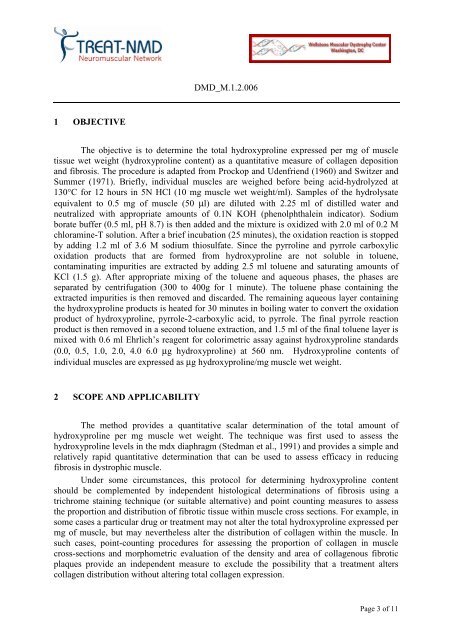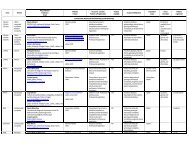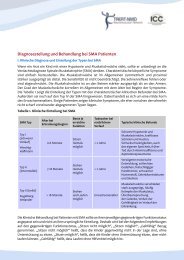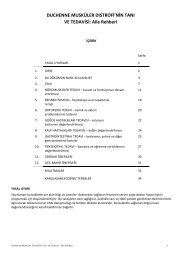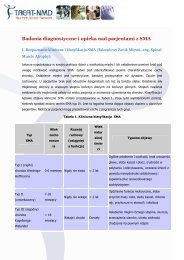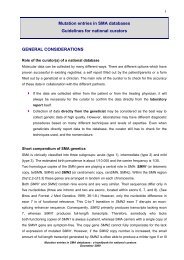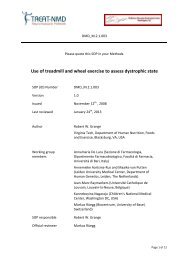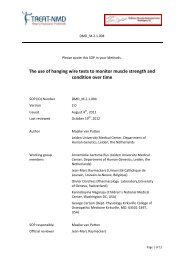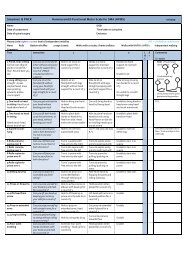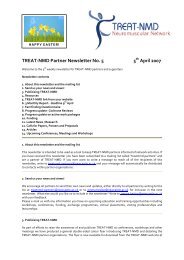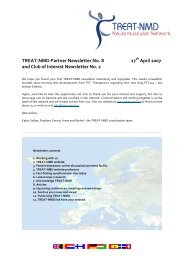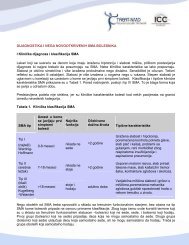Hydroxyproline assay - Treat-NMD
Hydroxyproline assay - Treat-NMD
Hydroxyproline assay - Treat-NMD
You also want an ePaper? Increase the reach of your titles
YUMPU automatically turns print PDFs into web optimized ePapers that Google loves.
DMD_M.1.2.006<br />
1 OBJECTIVE<br />
The objective is to determine the total hydroxyproline expressed per mg of muscle<br />
tissue wet weight (hydroxyproline content) as a quantitative measure of collagen deposition<br />
and fibrosis. The procedure is adapted from Prockop and Udenfriend (1960) and Switzer and<br />
Summer (1971). Briefly, individual muscles are weighed before being acid-hydrolyzed at<br />
130°C for 12 hours in 5N HCl (10 mg muscle wet weight/ml). Samples of the hydrolysate<br />
equivalent to 0.5 mg of muscle (50 µl) are diluted with 2.25 ml of distilled water and<br />
neutralized with appropriate amounts of 0.1N KOH (phenolphthalein indicator). Sodium<br />
borate buffer (0.5 ml, pH 8.7) is then added and the mixture is oxidized with 2.0 ml of 0.2 M<br />
chloramine-T solution. After a brief incubation (25 minutes), the oxidation reaction is stopped<br />
by adding 1.2 ml of 3.6 M sodium thiosulfate. Since the pyrroline and pyrrole carboxylic<br />
oxidation products that are formed from hydroxyproline are not soluble in toluene,<br />
contaminating impurities are extracted by adding 2.5 ml toluene and saturating amounts of<br />
KCl (1.5 g). After appropriate mixing of the toluene and aqueous phases, the phases are<br />
separated by centrifugation (300 to 400g for 1 minute). The toluene phase containing the<br />
extracted impurities is then removed and discarded. The remaining aqueous layer containing<br />
the hydroxyproline products is heated for 30 minutes in boiling water to convert the oxidation<br />
product of hydroxyproline, pyrrole-2-carboxylic acid, to pyrrole. The final pyrrole reaction<br />
product is then removed in a second toluene extraction, and 1.5 ml of the final toluene layer is<br />
mixed with 0.6 ml Ehrlich’s reagent for colorimetric <strong>assay</strong> against hydroxyproline standards<br />
(0.0, 0.5, 1.0, 2.0, 4.0 6.0 µg hydroxyproline) at 560 nm. <strong>Hydroxyproline</strong> contents of<br />
individual muscles are expressed as µg hydroxyproline/mg muscle wet weight.<br />
2 SCOPE AND APPLICABILITY<br />
The method provides a quantitative scalar determination of the total amount of<br />
hydroxyproline per mg muscle wet weight. The technique was first used to assess the<br />
hydroxyproline levels in the mdx diaphragm (Stedman et al., 1991) and provides a simple and<br />
relatively rapid quantitative determination that can be used to assess efficacy in reducing<br />
fibrosis in dystrophic muscle.<br />
Under some circumstances, this protocol for determining hydroxyproline content<br />
should be complemented by independent histological determinations of fibrosis using a<br />
trichrome staining technique (or suitable alternative) and point counting measures to assess<br />
the proportion and distribution of fibrotic tissue within muscle cross sections. For example, in<br />
some cases a particular drug or treatment may not alter the total hydroxyproline expressed per<br />
mg of muscle, but may nevertheless alter the distribution of collagen within the muscle. In<br />
such cases, point-counting procedures for assessing the proportion of collagen in muscle<br />
cross-sections and morphometric evaluation of the density and area of collagenous fibrotic<br />
plaques provide an independent measure to exclude the possibility that a treatment alters<br />
collagen distribution without altering total collagen expression.<br />
Page 3 of 11


